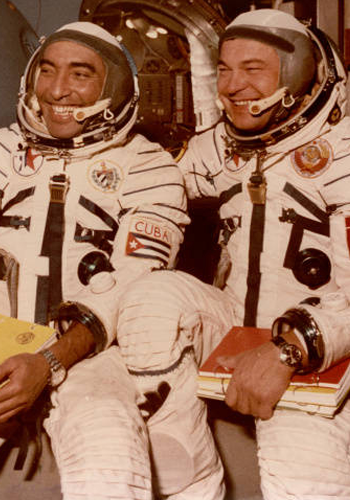Sunday, June 29, 1986.
REVOLUTIONS ARE RECALLED IN the Expo 86 films offered at the national pavilions of the United States, Cuba and Mexico. In each case, the presentation style is something less than revolutionary.
Mexico is presenting a 5½-minute untitled slide show that runs continuously as visitors pass through its pavilion. Produced by Multivision Audiovisual of Mexico City, it presents a pictorial impression of the nation's art and history, beginning with the Aztec calendar and following through to the revolution of 1910.
Thereafter the emphasis is on Mexico as a travel destination, with the 15-projector installation managing to vary the shape and composition of the screen image in a variety of eye-catching ways. The Mexican presentation overcomes its limitations of format and physical space — pictures are projected at second-story level on two right-angled walls — with a strikingly polished little show.
By contrast, the Cuban pavilion's seven-screen, untitled slide show is downright scruffy. Unexciting and amateurishly produced, it focuses on post-revolutionary Cuba's transport, agricultural and industrial systems. For most of its 20-minute running time, one screen remains dark, giving the impression of a partial breakdown.
As it turns out, the seventh screen is there for the show's surprise finale — motion picture footage of Cuban cosmonaut Arnaldo Tamayo Méndez. Together with Soviet spaceman Yuri Romanenko, Méndez was launched into orbit aboard Soyuz 38 on September 18, 1980, to perform a docking mission with Salut 6.
Visitors unaware of Méndez's achievement — the Cuban made it aloft a full four years before Canada's Mark Garneau — will be none the wiser even after seeing the launch footage. Cuba's show is neither narrated nor does it use descriptive titles.
Explanations are hardly necessary at the United States pavilion, where space exploration is the sole theme. Following exhibits paying tribute to America's space pioneers, a six-minute 70mm film, produced by Toronto's Christopher and Francis Chapman, documents a shuttle launch and then shows simulated docking manoeuvres at the proposed multi-national space station.
Despite its slickness, the U.S. movie is about as memorable as a trip to the laundromat. It's all so familiar. Then again, perhaps, we've finally overdosed on NASA.
The above is a restored version of a Province review by Michael Walsh originally published in 1986. For additional information on this archived material, please visit my FAQ.
Afterword: In retrospect, my reviews of the movies at the Cuban and U.S. pavilions seem to have offered an unconscious reflection of Canada's conflicted feelings on the cold war then raging in the Caribbean. In 1986, the U.S. trade embargo on the island nation had been a fact of life for more than 25 years. (Despite President Barack Obama's historic March 2016 visit to the Cuban capital, those sanctions remain in place to this day.) U.S. pressure notwithstanding, Ottawa maintained cordial relations with Havana, a relationship that was especially warm during the years when Pierre Elliot Trudeau was our prime minister. In 1976, Trudeau made a state visit to Cuba during which he began a lifelong friendship with President Fidel Castro. By contrast, U.S. political rhetoric about Cuba has been venomous for 56 years and counting.
If the Cuban pavilion's presentation was a little scruffy, it might have had something to do with the fact that the U.S., with a 1986 population of 240 million, was waging an economic war on Cuba's 10 million people. Over at the U.S. pavilion, Canada's best friend and closest trading partner was celebrating its victory in the space race, and showing off its plan to conquer the cosmos. Looking back, I notice that a funny thing happened along the way. In 2011, NASA shut down its shuttle program. Today, American astronauts on their way to the International Space Station hitch rides aboard Russian rockets launched from the same Baikonur Cosmodrome that played host to Arnaldo Tamayo Méndez in 1980.
And one more small memory from Expo 86: There was a counter in the Cuban pavilion where visiting Americans stood in line to buy genuine Havana cigars. It was a pleasure that was forbidden them in their own country, and the Cubans did a booming business as a result.
See also: The nine articles included in this, the second of four Expo 86 special reports, explore the pavilions of:
|
14: Expo 86 British Columbia 15: Expo 86 Canada/Washington State 16: Expo 86 Canada 17: Expo 86 California 18: Expo 86 Mexico/Cuba/USA |
